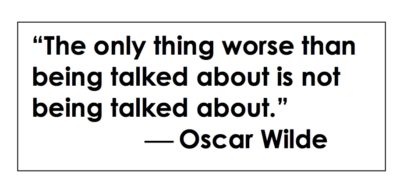
Okay, so you thought it was hard enough to write the darned book. Now you find out that you also have to be your own publicist!
PR 101: What is PR?
“A strategic communications process that helps manage, protect, and enhance the reputation of an organization, its members, and its services.” (IAMS Company website)
In the case of an author, PR can be used to build an image (or brand), reinforce the author’s reputation, raise awareness, educate, increase understanding, build credibility, and motivate your audience to action—that is, to BUY THE BOOK.
One way to increase your chances of achieving your goal of actually selling your book is by getting coverage from the media. However, just remember what Hubert Humphrey said about working with the media:
“It is always a risk to speak to the press. They are likely to report what you say.”
So how do you avoid those risky media gaffs? Plan ahead by creating a ready-to-go media kit that you can make available in print or electronic form. Having a solid media kit is one of the best ways to prepare for dealing with—not just those pesky reporters who are following you around—but anyone who wants information about you and your book: book reviewers, bloggers, indie bookstores, as well as the press.
“Taking time to collate all your resources and formatting them in a useful, clear way will make a journalist’s life easier and get them on your side,” says Hannah Hargrave, an award-winning book publicist.
So, what do you need to pull together to create this all-purpose media kit?
- First: you need a brief, concise—think 100-200 words—bio. It should be written in the third person and should inform the reader about the basic facts: where you were born, where you went to school, when you started writing, whether you have any other professional experience in writing, what other books you have written, where you are now. Also, be sure to include contact information.
- Second: you should prepare an author Q&A statement. Use this tool as a means for sharing additional info about yourself and your book that’s not already in your summary, excerpts, or bio. Here are a few sample questions to get started.
- Where did you get the idea for this book?
- What traits and other tidbits do you share with your main character?
- Did any of your inspiration for this book originate in your real-life?
- If you self-published, what made you decide to do so?
- Did you do everything yourself? Be generous with credit. It comes back to you.
- Are there any specific authors whose writing styles or subject matter inspired your book?
- How is your book relevant today?
- Do you have another project in the works? If so, what is it?
- Third: prepare a standard press release. You can get a template or format from Kindle or another online information provider. Basically, here’s the format:
- Headline – No more than 20 words
- Subheading – Optional, but sentence length
- Dateline – Location and date – include your city/state/country
- Intro – Needs to be attention grabbing – can include a problem/solution hook
- Author quotation – MUST be weighty – avoid bland, empty statements
- Mini author bio – Emphasis on mini (1-2 concise paragraphs) – every sentence must be impactful
- Book Information – Similar to the author bio – 1-2 impactful paragraphs, at most
- Contact details – A place to include links to your website, email, phone number, social media, and most importantly, how to get review copies
- Call to Action – It’s essential to end by telling how/where to buy your book, so pay due attention to this.
- Fourth: Create a sell sheet. What the heck is a sell sheet? It’s an everything-at-a-glance ad for your book; a concise, one-page document, like a flyer. The sell sheet was originally aimed at getting bookstores interested in carrying your book, but a sell sheet can also be sent out to reviewers, book clubs, the press, and anyone else whose attention you’d like to grab. Word of Caution: if you’re not familiar with Photoshop or InDesign, you might want to skip this part, or have a nice chat with someone who is familiar with these software programs, or with your publicist. If the sell sheet doesn’t look professional, it will not be useful. You can get some good advice about sell sheets at AIA Publishing.
- Fifth: Provide a couple of excerpts from your book. One should be no more than 100 words. Another could be longer (even a sample chapter, providing it’s not over 5 or 6 pages).
And that’s it! Yessir. Just that easy!


Pattie Macurdy
This is useful information, Mallory. Many thanks.
mallory oconnor
Glad you found it of use.
Mallory